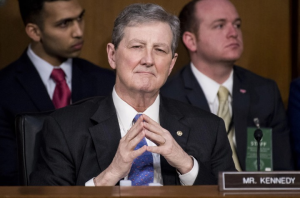The Unexpected Spark
Every now and then, the internet finds a moment that transcends its original context — a brief clip, a single line, or a few seconds of silence that manage to capture the imagination of millions. That’s exactly what happened when a short exchange between Representative Maxine Waters and Senator John Kennedy surfaced online this week. What began as a televised interaction quickly evolved into one of the most talked-about viral moments of the year, dominating social media platforms and sparking an avalanche of reactions, remixes, and memes.
The clip itself lasted less than twenty seconds, yet it became a defining example of how digital culture transforms real-time events into entertainment. Within hours of being posted, the snippet flooded timelines, drawing responses from every corner of the internet — from casual viewers to major influencers and even well-known brands.
How It All Began
It started during a routine public discussion that was being streamed live. Both Waters and Kennedy were mid-conversation when the unexpected occurred. Waters interrupted Kennedy mid-sentence, her tone steady yet firm, while Kennedy, momentarily caught off guard, paused before regaining his composure. The moment was subtle but electric — the kind of exchange that makes audiences lean forward.
Someone captured the clip, uploaded it to social media, and within hours, it had become the talk of the digital world. What stood out wasn’t just what was said, but how it was said — the tone, the pause, and the visible shift in body language that followed.

The Explosion on Social Media
Almost instantly, users on Platform X (formerly Twitter) began sharing and resharing the clip. Some described it as “unreal,” while others called it “television gold.” Hashtags began trending within hours, and by the end of the day, millions had seen the twenty-second exchange.
Comments poured in from every direction. One user wrote, “That silence afterward said everything.” Another posted, “I’ve replayed this ten times and it gets better every time.” The simplicity of the moment — one sentence, one pause, one shared silence — became fuel for endless interpretations and recreations.
TikTok Takes Over
The viral phenomenon quickly crossed over to TikTok, where creativity thrives on remixing and reimagining short clips. Users began posting their own versions, layering dramatic music, adding captions, or slowing the footage to highlight the tension and timing of the exchange. One edit used orchestral music for effect, turning the clip into a cinematic scene. Another zoomed in on Kennedy’s expression, looping the exact second of surprise for comedic effect.
Within just a few hours, one remix had gathered over eight million views, accompanied by a simple caption:
“Three seconds. One sentence. Internet history.”
From there, the variations multiplied. Some creators added laugh tracks. Others remade the scene with pets, coworkers, or even animated characters. Every version seemed to capture a different interpretation of the same moment — humor, confidence, tension, or sheer surprise. The meme had taken on a life of its own.

The Meme Storm on Instagram and X
By the following morning, screenshots of the moment had spread to Instagram, where meme pages and fan accounts gave it a new life. Text overlays appeared with captions like “When the meeting gets too real” or “That one coworker who doesn’t hold back.” Users turned Kennedy’s stunned expression into a universal reaction meme, pairing it with relatable everyday situations.
Some captions read:
-
“When you realize she wasn’t joking.”
-
“POV: You thought it was small talk.”
-
“When the WiFi drops mid-presentation.”
The image of Kennedy’s frozen reaction became a staple meme template within days, appearing in everything from pop culture threads to random group chats. It was no longer just about the exchange — it had evolved into a language of expression, a shared inside joke across the internet.
Going Beyond Politics
One of the most fascinating aspects of this viral moment was that it wasn’t about political debate. In fact, the majority of users engaging with it weren’t discussing the issue at hand at all. The appeal came from the delivery — the timing, the tension, and the sheer unpredictability of live television. People were analyzing tone, facial expressions, and silence rather than viewpoints.
It was pure digital theater. The internet, often quick to divide, found rare unity in humor and fascination. For a few days, it wasn’t about who was right or wrong — it was about a perfectly captured, human moment.
The Remix Culture in Action
Remix culture — where users take existing media and transform it creatively — was on full display. On TikTok and YouTube, creators began producing compilations titled “Maxine’s Boldest Moments” and “Kennedy’s Best Reactions.” Fans spliced together other clips of the two figures, edited with music, filters, and dramatic sound effects. Some added black-and-white film aesthetics and titles like “When calm meets chaos.”
Musicians joined in, too. One producer uploaded a remix of the clip to SoundCloud, starting with a beat drop right after the viral line. Its caption read, “The drop hits where Kennedy froze.” That version alone gained tens of thousands of plays overnight.
The more creative the edit, the faster it spread. By the end of the second day, the hashtag related to the exchange had amassed hundreds of millions of views collectively across all platforms.
Reaction Channels Join the Craze
As the clip gained traction, YouTube reaction channels joined the trend. Popular creators uploaded videos with titles like “Watching the Maxine Waters Clip for the First Time” or “Did She Really Just Say That?” The reactions were almost identical across the board — laughter, disbelief, and multiple replays. Comments poured in by the thousands, filled with versions of “She didn’t miss” and “That delivery deserves an award.”
This was another layer of virality — meta-content built around the original viral content. Each reaction video introduced new audiences to the clip, keeping it in circulation for days.
A Global Sensation
Soon, the moment transcended borders. Viewers from Europe, Asia, and South America began sharing subtitled versions of the clip. The line and the pause needed no translation — the emotion was universally understood. One viral tweet from a European user summed it up perfectly:
“You don’t need to know English to feel that burn.”
Across Reddit, international meme communities joined the trend, each adapting the clip to their own humor styles. Some even recreated it using animated characters or video game avatars. One creator produced an 8-bit-style version titled “Boss Level: Waters,” which quickly became a favorite among gaming fans.
The Hashtag Challenge Era
Within days, a new challenge began trending: the #MaxineWatersChallenge. It encouraged users to recreate their own “mic-drop” moments in everyday settings — at work, in classrooms, or even with pets. One viral video showed a cat interrupting another cat mid-meow, with captions mimicking the original dialogue. Another showed a barista delivering a witty comeback to a customer using the same audio line.
These re-creations transformed the exchange into a playful, global performance art experiment — a collective participation in digital culture.
Celebrities and Brands Join In
The moment became too big to ignore, and soon, celebrities joined the wave. Comedians, musicians, and influencers posted their takes. One well-known comedian wrote, “She meant every syllable.” A popular singer joked, “This deserves a Grammy for delivery alone.” Another influencer simply captioned their post with, “Maxine vs. Kennedy — I didn’t see THAT coming.”
Each repost reignited interest, sparking new waves of engagement. Brands followed suit, eager to join the conversation. A coffee company tweeted, “That moment when your espresso hits harder than Maxine’s line ☕️.” A tech brand shared a meme reading, “System error: Kennedy.exe has stopped responding.” Even fast-food chains joined in, joking, “When your order gets roasted harder than Kennedy on live TV.”
These playful responses showed how modern marketing often thrives on cultural moments. By tapping into the humor of the moment, brands kept themselves relevant — and users loved it.
From Viral Clip to Internet Folklore
By midweek, analytics reports showed staggering numbers. Mentions of the phrase spoken by Waters exceeded 120,000 across public posts within 48 hours. The most popular remix reached 22 million views on TikTok before being taken down for copyrighted audio. Fan pages dedicated solely to archiving every version of the clip appeared under names like “Waters Moments Archive” and “Kennedy Reaction Zone.” Their bios read: “We’re not political — we’re just here for the drama.”
This kind of cultural ripple effect is rare. What began as a real-time televised exchange had transformed into a shared, evolving piece of internet folklore.
The Anatomy of a Viral Moment
Why did this clip spread so fast? Analysts and creators alike pointed to a few key ingredients:
-
Relatability – Everyone knows what it feels like to be caught off guard or to witness a moment of unexpected confidence.
-
Emotion – The combination of tone, silence, and reaction conveyed authentic emotion — something audiences crave in the digital age.
-
Shareability – The short length made it ideal for reposting across multiple platforms.
-
Remix Potential – The line’s rhythm and timing made it perfect for audio remixes and meme adaptations.
Viral moments often share these traits: brevity, emotion, and endless adaptability.
Lessons from the Trend
Digital culture experts noted that this phenomenon reflects how audiences now consume and interact with media. Viewers no longer just watch — they participate. A single clip can evolve into countless creative interpretations within hours, each one amplifying the original.
It also demonstrates how humor can unite audiences across backgrounds and viewpoints. Even though the moment originated in a political setting, the viral life it gained was entirely cultural and social, not partisan.
A Moment Frozen in Time
As the week came to a close, the buzz slowly began to fade, but its digital footprint remained enormous. Search trends showed both names skyrocketing in popularity. GIFs of the moment continued circulating in group chats and comment sections, used to express everything from awkwardness to triumph.
In the end, it wasn’t just about what was said — it was about how the moment made people feel. It reminded audiences that authenticity, emotion, and timing can turn even a brief exchange into something unforgettable.
The Takeaway: When Culture Meets Connection
The viral exchange between Maxine Waters and Senator John Kennedy is a perfect example of how modern audiences engage with live media. A few seconds of conversation, captured in real time, became a shared cultural experience for millions. The internet doesn’t just consume content — it transforms it, giving new meaning and humor to even the most ordinary interactions.
For a brief moment, the world stopped scrolling to watch two people share a line that became larger than itself. And in an era where attention spans are fleeting, that kind of digital unity is something truly extraordinary.
